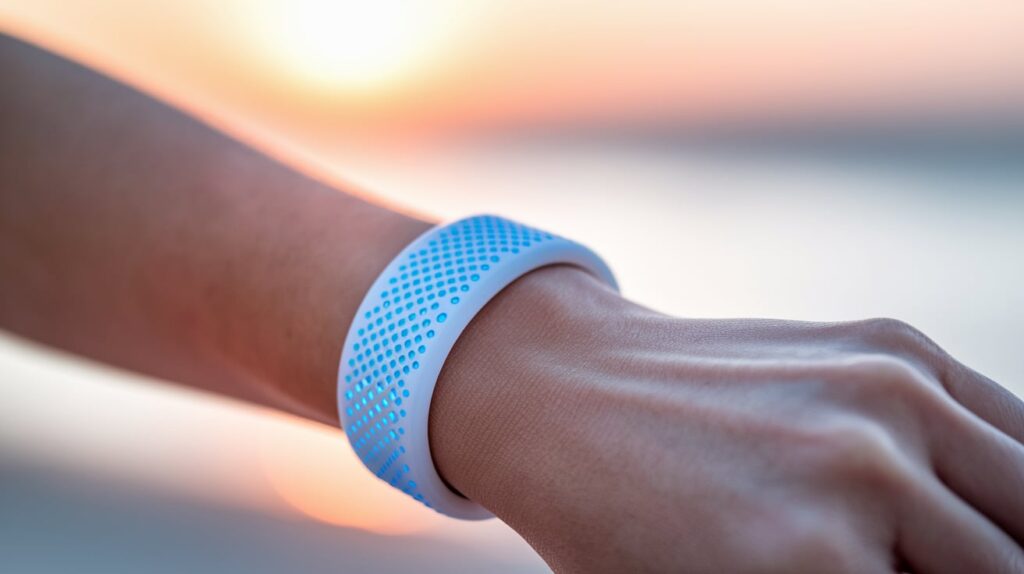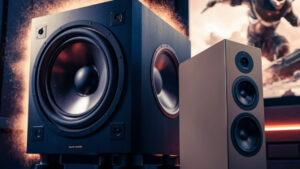Have you ever found yourself dreading a road trip or feeling anxious about your next flight because of motion sickness? You’re not alone.
Recommended Best Motion Sickness Bands in 2025
| Recommendation | Product |
| Best Overall | EmeTerm Explore Anti-Nausea Wristband |
| Popular Choice | Sea-Band Anti-Nausea Acupressure Wristband |
| Best Value | HIONXMGA Motion Sickness Bands |
| Best Budget | LYJEE 5 Pairs Motion Sickness Bands |
| Another Excellent Pick | Hionfurt Motion Sickness Bands |
Motion sickness can turn the excitement of travel into a miserable experience. But what if there’s a simple solution that doesn’t involve medication or side effects? Motion sickness bands promise relief with just a gentle pressure on your wrist. Sounds intriguing, right?
Before you dismiss them as another gimmick, let’s dive into how these bands work and whether they could be the answer you’ve been searching for. Your comfort and freedom from nausea might be just a wristband away, and we’re here to explore how effective they really are. Keep reading to discover the science behind these bands and whether they can transform your travel experiences from dreadful to delightful.

What Are Motion Sickness Bands?
Motion sickness bands offer a non-medicinal solution to alleviate nausea during travel. They use acupressure to reduce symptoms, providing relief for many users. Some find them effective, while others report minimal benefits.
Motion sickness can turn a joyous journey into a distressing experience, leaving you feeling nauseous and dizzy. Many people have turned to motion sickness bands as a solution. But what are these bands, and how do they work? Understanding the basics can help you determine if they might be a viable option for your next trip.
Motion sickness bands are designed to provide relief by using acupressure, an ancient technique that applies pressure to specific points on the body. These bands typically have a small, round button that presses against the P6 point on your wrist. It’s believed that stimulating this point can help reduce feelings of nausea. Some might wonder if a small band can make a difference, but many users report feeling better with them.
What Are They Made Of?
These bands are usually made from elastic materials, ensuring a snug fit. They’re available in various sizes to accommodate both adults and children. Some brands even offer waterproof options, allowing you to wear them during swimming or in rainy weather. This versatility means you can use them in various scenarios, whether you’re flying, sailing, or on a road trip.
Are They Effective For Everyone?
Effectiveness can vary from person to person. Some people swear by them, while others might not notice any difference. If you’re curious about trying them, they’re relatively inexpensive and easy to find in pharmacies or online. Experimenting on a short trip first might help you gauge their effectiveness for you. Have you ever tried alternative remedies for motion sickness?
How To Wear Motion Sickness Bands Correctly?
Wearing them properly is crucial for them to work. Place the band on your wrist with the button pressing firmly against the P6 point, located about three finger-widths from the base of your palm. Make sure it’s snug but not too tight. This ensures the right amount of pressure is applied for optimal relief. Have you ever wondered if there’s a simple solution to your travel woes? Perhaps a motion sickness band is worth a try.
Types Of Motion Sickness Bands
Motion sickness bands come in various types, each offering unique methods to combat the discomfort of motion sickness. Whether you’re planning a road trip, flying across the country, or setting sail for a cruise, understanding these options can be incredibly helpful. Let’s dive into the different types of motion sickness bands and explore how they can be effective in managing your symptoms.
Acupressure Bands
Acupressure bands are perhaps the most well-known type. They work by applying pressure to a specific point on your wrist. This point, known as the P6 or Nei-Kuan point, is believed to help alleviate nausea and vomiting. You might be wondering if simply pressing a spot on your wrist can truly make a difference. Many users swear by them, sharing stories of relief during long car rides and turbulent flights.
The simplicity of acupressure bands makes them appealing. They don’t require batteries or complex instructions. Just wear the band snugly, ensuring the button is placed correctly on your wrist. This ease of use allows you to focus on enjoying your journey rather than worrying about motion sickness.
Magnetic Bands
Magnetic bands add a twist to the traditional acupressure technique. They incorporate magnets to enhance the pressure application. The idea is that magnets might boost circulation and reduce nausea. It’s intriguing to think about how a small magnet can potentially improve your travel experience.
Some users find magnetic bands more effective than regular acupressure bands. If you’re skeptical, it might be worth trying one during your next trip. After all, you won’t know its effectiveness until you experience it firsthand.
Electronic Bands
Electronic bands are the high-tech option in the world of motion sickness management. These bands use gentle electrical pulses to stimulate the P6 point on your wrist. The pulses are intended to block the nausea signals sent to your brain, providing relief.
Imagine having a mini gadget on your wrist that actively works to keep nausea at bay. It’s a fascinating concept that attracts tech-savvy travelers. While they can be pricier than other options, their effectiveness might just justify the investment. Would you be willing to try an electronic band for guaranteed comfort during your travels?
Each type of motion sickness band offers a unique approach to combating nausea. Whether you prefer a natural method or are open to trying tech-enhanced solutions, there’s likely a band that suits your needs. Consider experimenting with different types to find what works best for you. Your next adventure could be a lot more pleasant with the right motion sickness band by your side.
How Do Motion Sickness Bands Work?
Motion sickness bands have become a popular remedy for nausea and dizziness experienced during travel. But how do these bands actually work? Understanding the science behind them can help you decide if they are the right solution for your queasiness.
Principles Of Acupressure
The foundation of motion sickness bands lies in acupressure, an ancient practice from traditional Chinese medicine. These bands apply pressure to the P6 acupressure point located on your wrist. This point is believed to connect with the nervous system to alleviate symptoms like nausea. Have you ever noticed how pressing on certain parts of your body can provide relief? This is the magic of acupressure.
Imagine you’re on a rocky boat ride, feeling the churn in your stomach. The bands aim to intercept this feeling by stimulating the acupressure point. It’s like having a personal masseuse targeting that exact spot to calm your queasiness.
Role Of Magnets
Some motion sickness bands incorporate magnets into their design. The idea is that magnetic fields can enhance the effect of acupressure. Magnetic therapy is thought to influence the body’s electromagnetic fields, promoting balance and reducing discomfort.
Picture the magnets as an extra boost, amplifying the pressure point’s calming influence. While studies on magnets are varied, many users report feeling a difference. Do you think a small magnet could change how your body reacts to motion?
Mechanism Of Electronic Stimulation
Advanced motion sickness bands use electronic stimulation to tackle nausea. These bands emit gentle electrical impulses to the wrist. The sensation is similar to a mild tingling or vibration. This approach can be particularly helpful for those who find manual pressure insufficient.
Imagine the electronic pulses as tiny rescuers, working to ease the turbulence in your stomach. This technology is akin to the TENS units used in physical therapy, providing non-invasive relief. Could these electrical signals be the key to your comfort during travel?
Ultimately, the effectiveness of motion sickness bands varies among individuals. They offer a non-drug alternative that taps into ancient practices and modern technology. Whether through acupressure, magnets, or electronic stimulation, these bands aim to provide a smoother journey. Have you tried them on your travels? If not, they might be worth a shot the next time you hit the road or sea.
Scientific Evidence And Studies
Recent studies highlight motion sickness bands as a promising remedy. These bands apply pressure to specific wrist points. Research suggests they effectively reduce nausea symptoms for many users.
When considering the effectiveness of motion sickness bands, scientific evidence and studies play a crucial role in understanding how well these bands perform. These bands, often found wrapped around wrists during travel, claim to alleviate nausea and dizziness. But what does science say about their effectiveness? Let’s dive into the research and see how these bands stand up to scrutiny.
Clinical Trials
Clinical trials provide valuable insights into how effective motion sickness bands truly are. Researchers have conducted studies that show varying results. Some trials reveal significant relief from nausea, while others indicate minimal to no impact. For example, a study involving a group of sailors found that those wearing the bands reported a noticeable decrease in motion sickness symptoms compared to those who didn’t. This suggests a potential benefit, although results can vary based on individual differences.
User Testimonials
User testimonials offer a more personal perspective on the effectiveness of motion sickness bands. Many users swear by these bands, claiming they transform their travel experiences. One frequent traveler shared how the bands turned dread-filled flights into enjoyable journeys. However, not everyone shares the same enthusiasm. Some users find little to no relief, highlighting the subjective nature of this remedy. Have you ever tried these bands? How did they work for you?
Comparative Studies
Comparative studies shed light on how motion sickness bands measure up against other remedies. Researchers often compare them with medications or placebo treatments. In some cases, bands perform on par with medications, offering a drug-free alternative. However, in other scenarios, traditional medications might outperform bands in terms of effectiveness. The choice between a band and medication might depend on your preference for natural solutions versus pharmaceutical ones.
Scientific evidence presents a mixed picture. While some find relief with motion sickness bands, others might not experience the same benefits. It’s important to consider both scientific findings and personal experiences when deciding if these bands are right for you. What works for one person might not work for another. Would you be willing to give them a try on your next journey?
Benefits Of Motion Sickness Bands
Motion sickness bands can reduce nausea during travel by using acupressure techniques. These bands are effective, drug-free solutions for many people. Comfort and ease of use make them popular among travelers seeking relief.
Motion sickness can be a real downer, especially when you’re trying to enjoy a long-awaited vacation or a scenic road trip. The discomfort of nausea and dizziness can quickly turn any adventure into a nightmare. Thankfully, motion sickness bands offer a practical solution to this common problem. These bands are gaining popularity for their simplicity and effectiveness. Let’s delve into the benefits they bring to the table.
Non-invasive Solution
Motion sickness bands provide relief without the need for invasive methods. Unlike medications or patches that might cause side effects, these bands work externally. They apply gentle pressure to specific points on your wrist to alleviate symptoms, making them an easy choice for many.
If you’ve ever felt wary about taking pills due to potential side effects, motion sickness bands offer a safe alternative. You don’t have to ingest anything or worry about drowsiness. The non-invasive nature of these bands ensures that you remain alert and ready to enjoy your journey.
Drug-free Relief
One of the standout benefits of motion sickness bands is their drug-free approach. You can experience relief without introducing chemicals into your body. This is especially beneficial for those who prefer natural remedies or have allergies to certain medications.
Imagine setting sail on a cruise, knowing you won’t need to pop pills every few hours. Instead, a simple band around your wrist keeps nausea at bay. For families with children, this drug-free method means no concerns about dosages or side effects.
Ease Of Use
Using motion sickness bands couldn’t be simpler. They are designed for easy wear, making them accessible for anyone, regardless of age. With clear instructions, you can place them on your wrist in seconds and feel the difference.
These bands are lightweight and portable, fitting snugly in your travel kit. Whether you’re hopping on a plane or taking a long drive, just slip them on and forget they’re even there. Have you ever struggled with medication packaging? These bands eliminate that hassle, offering relief with minimal effort.
Motion sickness bands are not just a practical solution; they’re a game changer for those prone to travel-induced nausea. Whether you’re a frequent traveler or planning your first big trip, consider giving these bands a try. They might just be the key to keeping your travels smooth and enjoyable.
Limitations And Considerations
Motion sickness bands offer relief for many, yet they have limitations. Understanding these can help make informed decisions. While many users praise their effectiveness, others find them less helpful. It’s crucial to explore the potential drawbacks and factors influencing their performance. Let’s dive deeper into these considerations.
Effectiveness Variability
Not everyone experiences relief with motion sickness bands. Individual responses vary greatly. Some find immediate comfort, others notice little change. Factors like age and health affect their effectiveness. Personal sensitivity to pressure points may also play a role. It’s essential to test them to see if they work for you.
Potential Side Effects
While generally safe, some users report mild side effects. These can include skin irritation or discomfort from the band. Pressure from the band might cause soreness over time. Ensure the band is not too tight to avoid these issues. Monitoring skin for irritation is wise for prolonged use.
Situational Suitability
Motion sickness bands may not suit every situation. Their effectiveness can vary with activity type. They might work well for car rides but less so for turbulent flights. Consider the intensity of your motion sickness before relying solely on bands. Evaluating the situation helps determine their suitability.
Tips For Using Motion Sickness Bands
Motion sickness bands help manage nausea by applying pressure to specific wrist points. Their effectiveness varies among users but many find relief. Trying different brands and adjusting placement might enhance results.
Are you tired of feeling queasy every time you travel? Motion sickness bands might be your answer. These simple wristbands can significantly ease the uncomfortable symptoms of motion sickness. However, understanding how to use them correctly is crucial for maximum effectiveness. Below are some practical tips to ensure you get the most out of your motion sickness bands.
Correct Placement
The placement of your motion sickness band is key. It should sit on your wrist, about two inches from the base of your palm. This spot is known as the Nei-Kuan point. Applying gentle pressure here can help relieve nausea.
Have you ever worn a watch too tightly? You’ll want to avoid that feeling. The band should be snug but comfortable, allowing for steady pressure without cutting off circulation.
Timing For Best Results
Timing can make all the difference. For best results, wear the bands at least 30 minutes before your journey begins. This gives your body time to adjust and helps prevent nausea before it starts.
Consider your past experiences with motion sickness. Have you noticed symptoms starting at specific times? Adjust your timing accordingly. Wearing the bands early can be a preventive measure rather than a reactive one.
Complementary Techniques
While motion sickness bands can be highly effective, combining them with other techniques can enhance their benefits. Deep breathing exercises, focusing on a fixed point, or listening to calming music can further ease your symptoms.
Think about your last road trip. Did sipping ginger tea or munching on a light snack help? Pairing these techniques with your wristbands could be the key to a more comfortable journey.
Remember, motion sickness bands aren’t a magic solution, but when used correctly, they can significantly improve your travel experience. Are you ready to test them out on your next adventure?
Alternative Remedies For Motion Sickness
Motion sickness can be a real nuisance when you’re trying to enjoy a road trip, a cruise, or even a flight. While motion sickness bands are popular, there are several other remedies you might consider. These alternatives can offer relief and help you enjoy your journey without the queasiness. So, what are your options?
Medications
Over-the-counter medications like Dramamine and Bonine are often recommended. They work by blocking the signals your inner ear sends to your brain, which are responsible for the nausea and dizziness.
Prescription medications are also available for severe cases. It’s crucial to consult your doctor to determine which option suits your needs.
Do you worry about side effects? Some medications can cause drowsiness, so it’s wise to test them before a big trip.
Natural Remedies
Ginger is a favorite among natural remedies. You can take it as a tea, chewable candy, or supplement. Many find it effective in calming the stomach.
Peppermint oil is another option. It can be applied to your temples or inhaled to provide relief. Have you ever tried aromatherapy for motion sickness?
Acupressure, like the kind used in motion sickness bands, is also available through specific points on your wrist. Some swear by its effectiveness.
Lifestyle Changes
Eating smaller, lighter meals before traveling can make a big difference. Heavy meals may worsen your symptoms.
Staying hydrated is essential. Dehydration can intensify feelings of nausea. Keep a water bottle handy.
Consider your seating choice. Facing forward and choosing seats with minimal movement, like the middle of a ship, can help stabilize your experience.
Alternative remedies for motion sickness are plentiful. Have you found what works best for you? Share your experiences and tips with others who may still be searching for relief.
Future Of Motion Sickness Solutions
The future of motion sickness solutions holds promising advancements. As technology evolves, new methods to combat motion sickness emerge. Traditional remedies like bands are being reimagined. These innovations aim to enhance user experience and effectiveness.
Innovations In Technology
Technological innovations are transforming motion sickness treatments. Smart bands now monitor bodily responses. They adjust pressure based on real-time feedback. This personalization increases their effectiveness. Wearable tech offers convenience and adaptability. Users find relief in dynamic settings.
Potential For Enhanced Effectiveness
Enhanced effectiveness is a key goal for future solutions. Research focuses on materials that offer better comfort and pressure distribution. Scientists explore new ways to stimulate the wrist’s pressure points. These efforts aim to improve relief rates. The results could provide quicker and more reliable relief for users.
Integrating With Other Therapies
Integration with other therapies is becoming more common. Combining motion sickness bands with cognitive exercises shows potential. This synergy enhances the overall treatment experience. Aromatherapy and mindfulness techniques are also considered. They offer holistic approaches to managing symptoms. The blend of therapies provides comprehensive care.
Frequently Asked Questions
Do Seasickness Bands Really Work?
Seasickness bands use acupressure to relieve nausea. Many users report effectiveness, though results vary. They’re drug-free and non-invasive. Some people find them helpful, while others may not experience relief. Trying them can be a simple way to address seasickness symptoms.
How Long Does It Take For Motion Sickness Bands To Work?
Motion sickness bands typically start working within 10-15 minutes. They apply pressure to specific wrist points to alleviate symptoms. Ensure proper placement for effective results. These bands offer a drug-free solution and are suitable for travel. Always check product instructions for accurate usage.
Does Reliefband Work For Motion Sickness?
Yes, Reliefband effectively reduces motion sickness symptoms. It uses neuromodulation technology to stimulate nerves and alleviate nausea. Many users find it helpful during travel. Adjust the intensity for optimal results. Always follow usage instructions for best outcomes.
What Really Works For Motion Sickness?
Ginger tea or tablets can help ease motion sickness. Over-the-counter antihistamines like Dramamine are effective. Fresh air, focusing on a distant point, and small sips of water also alleviate symptoms. Acupressure wristbands apply pressure to reduce nausea. Consult a doctor for persistent issues.
Conclusion
Motion sickness bands can offer relief for many people. Their effectiveness varies among users. Some find them helpful; others see limited benefits. The bands work by applying pressure to certain wrist points. This ancient method, called acupressure, targets nausea. Easy to use and non-invasive.
But results differ from person to person. Consider personal needs and consult a doctor if unsure. Motion sickness bands might be worth trying for gentle relief. Explore this option, but stay informed about other remedies. Your comfort is important, so choose wisely for your travels.








